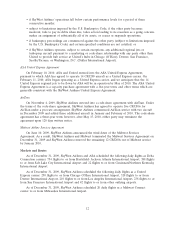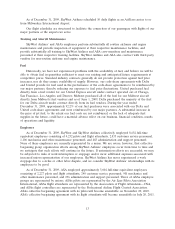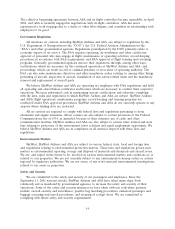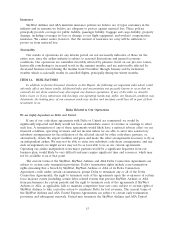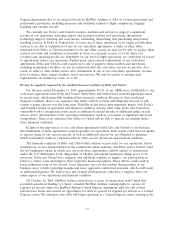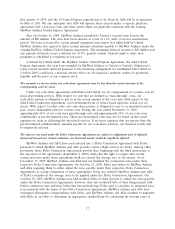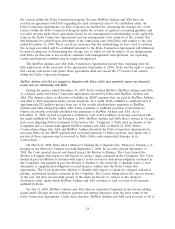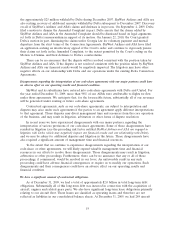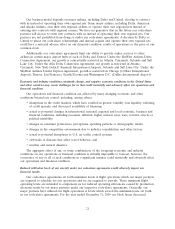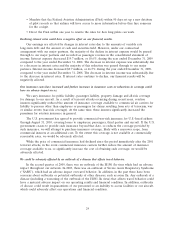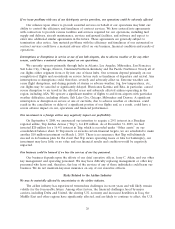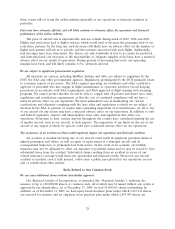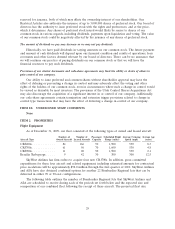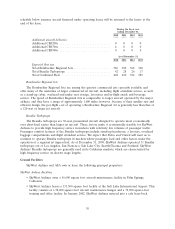SkyWest Airlines 2009 Annual Report Download - page 24
Download and view the complete annual report
Please find page 24 of the 2009 SkyWest Airlines annual report below. You can navigate through the pages in the report by either clicking on the pages listed below, or by using the keyword search tool below to find specific information within the annual report.under lease, with remaining terms ranging from one to 17 years. Future minimum lease payments due
under all long-term operating leases were approximately $2.9 billion at December 31, 2009. At a 5.8%
discount factor, the present value of these lease obligations was equal to approximately $2.1 billion at
December 31, 2009. As of December 31, 2009, we had commitments of approximately $98.0 million to
purchase four CRJ700s. We expect to complete these deliveries by the first quarter of 2010. Our high
level of fixed obligations could impact our ability to obtain additional financing to support additional
expansion plans or divert cash flows from operations and expansion plans to service the fixed
obligations.
There are risks associated with our regional jet strategy, including potential oversupply and possible passenger
dissatisfaction.
Our selection of Bombardier Regional Jets as the primary aircraft for our existing operations and
projected growth involves risks, including the possibility that there may be an oversupply of regional
jets available for sale in the foreseeable future, due, in part, to the financial difficulties of regional and
major airlines, including Delta, United, Comair, Mesa and ExpressJet. A large supply of regional jets
may allow other carriers, or even new carriers, to acquire aircraft for unusually low acquisition costs,
allowing them to compete more effectively in the industry, which may ultimately harm our operations
and financial performance.
Our regional jet strategy also presents the risk that passengers may find the Bombardier Regional
Jets to be less attractive than other aircraft, including other regional jets. Recently, several other
models of regional jets have been introduced by manufacturers other than Bombardier. If passengers
develop a preference for other regional jet models, our results of operation and financial condition
could be negatively impacted.
We may be limited from expanding our flying within the Delta and United flight systems, and there are
constraints on our ability to provide airline services to airlines other than Delta and United.
Additional growth opportunities within the Delta and United flight systems are limited by various
factors. Except as currently contemplated by our existing code-share agreements, we cannot assure that
Delta or United will contract with us to fly any additional aircraft. We may not receive additional
growth opportunities, or may agree to modifications to our code-share agreements that reduce certain
benefits to us in order to obtain additional aircraft, or for other reasons. Furthermore, the troubled
financial condition, bankruptcies and restructurings of Delta and United may reduce the growth of
regional flying within their flight systems. Given the troubled nature of the airline industry, we believe
that some of our competitors may be more inclined to accept reduced margins and less favorable
contract terms in order to secure new or additional code-share operations. Even if we are offered
growth opportunities by our major partners, those opportunities may involve economic terms or
financing commitments that are unacceptable to us. Any one or more of these factors may reduce or
eliminate our ability to expand our flight operations with our existing code-share partners. Additionally,
even if Delta and/or United choose to expand our fleet on terms acceptable to us, they may be allowed
at any time to subsequently reduce the number of aircraft covered by our code-share agreements. We
also cannot provide any assurance that we will be able to obtain the additional ground and
maintenance facilities, including gates, and support equipment, to expand our operations. The failure to
obtain these facilities and equipment would likely impede our efforts to implement our business
strategy and could materially adversely affect our operating results and our financial condition.
Delta, United and/or AirTran may be restricted in increasing their business with us, due to ‘‘scope’’
clauses in the current collective bargaining agreements with their pilots that restrict the number and
size of regional jets that may be operated in their flight systems not flown by their pilots. Delta’s scope
limitations restrict its partners from operating aircraft with over 76 seats, even if those aircraft are
operated for an airline other than Delta. We cannot assure that these scope clauses will not become
more restrictive in the future. Any additional limit on the number of regional jets we can fly for our
code-share partners could have a material adverse effect on our expansion plans and the price of our
common stock.
20




